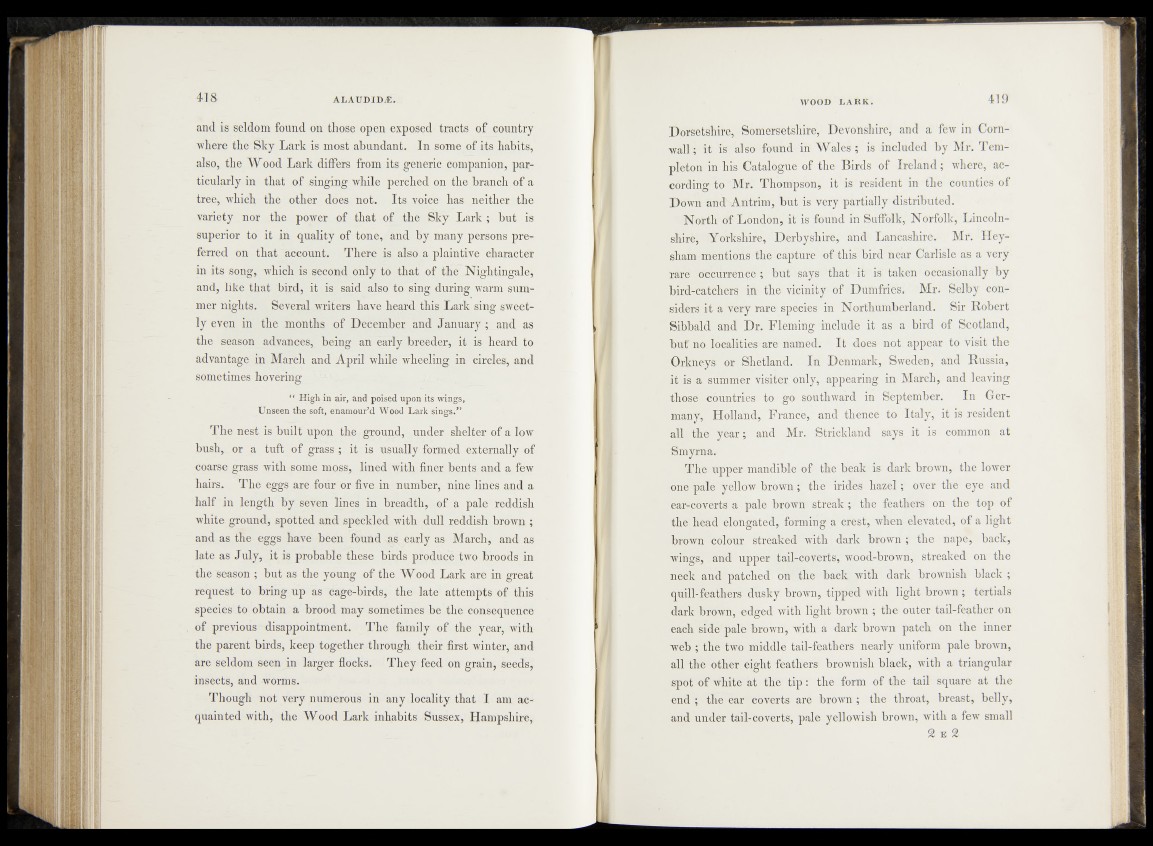
and is seldom found on those open exposed tracts of country
Avhere the Sky Lark is most abundant. In some of its habits,
also, the Wood Lark differs from its generic companion, particularly
in that of singing while perched on the branch of a
tree, which the other does not. Its voice has neither the
variety nor the power of that of the Sky L a rk ; but is
superior to it in quality of tone, and by many persons preferred
on that account. There is also a plaintive character
in its song, which is second only to that of the Nightingale,
and, like that bird, it is said also to sing during warm summer
nights. Several writers have heard this Lark sing sweetly
even in the months of December and January ; and as
the season advances, being an early breeder, it is heard to
advantage in March and April while wheeling in circles, and
sometimes hovering
“ High in air, and poised upon its wings,
Unseen the soft, enamour’d Wood Lark sings.”
The nest is built upon the ground, under shelter of a low
bush, or a tuft of grass; it is usually formed externally of
coarse grass with some moss, lined with finer bents and a few
hairs. The eggs are four or five in number, nine lines and a
half in length by seven lines in breadth, of a pale reddish
white ground, spotted and speckled with dull reddish brown ;
and as the eggs have been found as early as March, and as
late as July, it is probable these birds produce two broods in
the season ; but as the young of the Wood Lark are in great
request to bring up as cage-birds, the late attempts of this
species to obtain a brood may sometimes be the consequence
of previous disappointment. The family of the year, with
the parent birds, keep together through their first winter, and
are seldom seen in larger flocks. They feed on grain, seeds,
insects, and worms.
Though not very numerous in any locality that I am acquainted
with, the Wood Lark inhabits Sussex, Hampshire,
Dorsetshire, Somersetshire, Devonshire, and a few in Cornwall;
it is also found in Wales; is included by Mr. Templeton
in his Catalogue of the Birds of Ireland; where, according
to Mr. Thompson, it is resident in the counties of
D own and Antrim, but is very partially distributed.
North of London, it is found in Suffolk, Norfolk, Lincolnshire,
Yorkshire, Derbyshire, and Lancashire. Mr. Hey-
sham mentions the capture of this bird near Carlisle as a very
rare occurrence ; but says that it is taken occasionally by
bird-catchers in the vicinity of Dumfries. Mr. Selby considers
it a very rare species in Northumberland. Sir Robert
Sibbald and Dr. Fleming include it as a bird of Scotland,
buf no localities are named. It does not appear to visit the
Orkneys or Shetland. In Denmark, Sweden, and Russia,
it is a summer visiter only, appearing in March, and leaving
those countries to go southward in September. In Germany,
Holland, France, and thence to Italy, it is resident
all the year; and Mr. Strickland says it is common at
Smyrna.
The upper mandible of the beak is dark brown, the lower
one pale yellow brown; the irides hazel; over the eye and
ear-coverts a pale brown streak ; the feathers on the top of
the head elongated, forming a crest, when elevated, of a light
brown colour streaked with dark brown ; the nape, back,
wings, and upper tail-coverts, wood-brown, streaked on the
neck and patched on the back with dark brownish black ;
quill-feathers dusky brown, tipped with light brown ; tertials
dark brown, edged with light brown ; the outer tail-feather on
each side pale brown, with a dark brown patch on the inner
web ; the two middle tail-feathers nearly uniform pale brown,
all the other eight feathers brownish black, with a triangular
spot of white at the tip : the form of the tail square at the
end ; the ear coverts are brown ; the throat, breast, belly,
and under tail-coverts, pale yellowish brown, with a few small
2 e 2